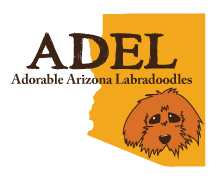Q. What types of coats do your dogs have?
A. Most of our puppies have a loose curl fleece to a wavy fleece. Occasionally, we get puppies with curly coats. We sometimes get puppies with wool coats, but these are very rare.
Q. Which coats are the easiest to maintain?
A. Loose curl fleece, wavy fleece, and single coats.
Q. Which coats are the most allergy friendly?
A. Any fleece coat is allergy-friendly (though curly and wool are the best).
Q. At what age do they blow their puppy coat?
A. Puppies begin blowing (shedding) their puppy coats at about 10 months. The entire process can take a couple of months to a year; it depends on the dog.
Q. What tools do you recommend for grooming? How often do I need to comb out my puppy?
A. My favorite brush is the Les Pooch, but there are other more affordable options, too. Use a comb after the slicker. You will want to do this every four days to keep mats from forming.
Q. At what age should I take my puppy to obedience school?
A. The ideal age to take your labradoodle puppy to obedience school is at 4 months old, right after he has completed all of his vaccinations.
Q. How do I stop my puppy from nipping?
A. All puppies nip or bite, but there are a number of ways to correct this behavior. Take ahold of his/her snout with your left hand and gently bump your thumb across the bridge of the nose. Say “no biting” in a firm voice.
Often, this alone will stop the nipping. If the puppy continues nipping after you have corrected him/her, then bump the fingers of your left hand (still on the snout) with your right hand. Not too had or too soft. This works really well. Puppies’ mothers smack the pups under the chin when they are biting their ears too hard.
Q. What can I do about chewing?
A. Toys! Whenever you catch your labradoodle chewing on something he shouldn’t, take it away and give him a Nylabone. Bitter apple flavor will also discourage a puppy from chewing.
Q. What is the fear and anxiety period?
A. This occurs at 8-10 weeks. It’s vital that the puppy have as many positive experiences with people, other animals, and new situations as possible.
Avoid painful or scary experiences until after 11 weeks. Those mildly unpleasant experiences that can’t be avoided (like puppy shots) should be turned into positive ones by your reaction. Always “jolly up” a scared puppy by laughing, praising the puppy, and treating the event as a game. Never give the appropriately human empathetic response of soothing reassurance, as this convinces the puppy that it must be really awful since you’re upset too.
Q. At what age do you stop feeding puppy food and begin adult food?
A. Between six months and one year. At Adorable Down East Labradoodles, we usually switch to adult food after six months.
Q. What dog food do you recommend?
A. Human-grade foods with no fillers. Please visit our “Bringing your puppy home” page for a full list of foods that we recommend.
Q. What type of collar and leash do you recommend?
A. Any good collar or leash works, though we prefer Lupine leashes and collars.
Q. Do you recommend a harness? If so, what kind?
A. We like easy walk halters for walking or hiking — they are better on labradoodles’ necks.
Q. At what age do puppies usually sleep through the night? What can I do to get my puppy to encourage my puppy to do that?
A. Most of my puppies will start sleeping through the night during crate training, although this also depends on the size of your labradoodle.
Q. Do all labradoodles like the water?
A. Just like people, individual labradoodles have individual personalities. Some love water, some don’t. Considering their ancestors (poodles and labradors), there is an increased chance that they will like water. The same goes for fetching. You can work (gently!) to encourage an interest in swimming or fetching.
Q. My puppy sleeps a lot. Is that normal?
A. It is completely normal! All puppies sleep at least 18 hours a day — just like human babies, they need a lot of rest in order to grow big and strong!
Q. Is it OK to have my puppy sleep in the laundry room?
A. Labradoodles are people dogs — they love and want to be close to their family. They can sleep in an isolated area such as the laundry room, but they much prefer to sleep on a doggie bed near you.
